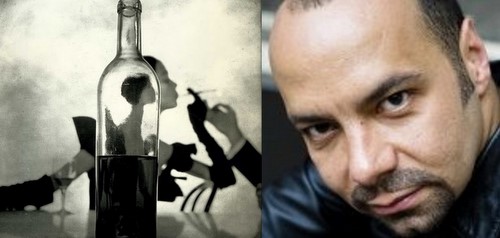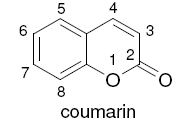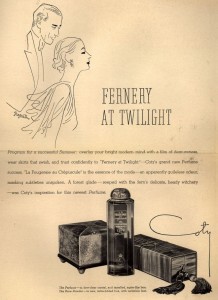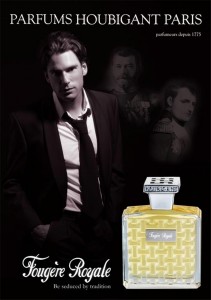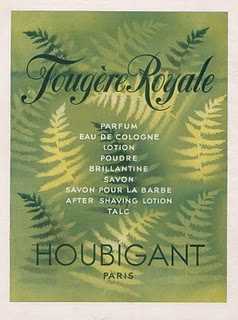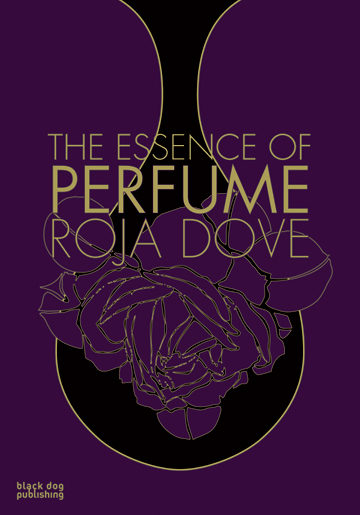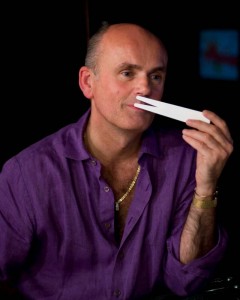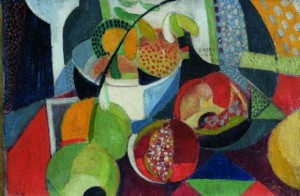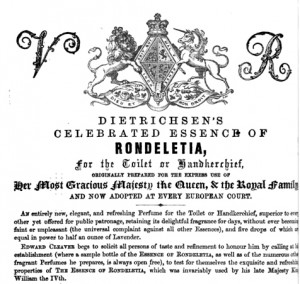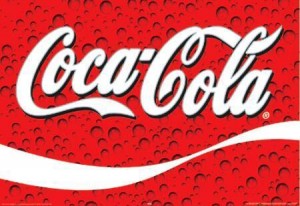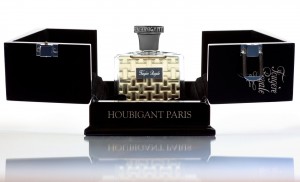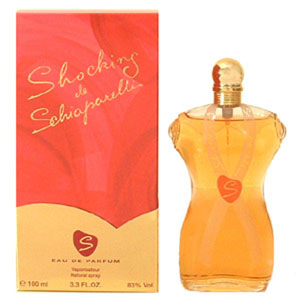This is going to be a slightly different version of Behind the Bottle, although it started the same way in concept. At the recent Sniffapalooza Spring Fling 2011 I had a chance to smell the parfum version of the modern reformulation of Houbigant Fougere Royale. I had named the Eau de Parfum version of Fougere Royale one of my top new fragrances of 2010 and was amazed at how rich and special the parfum version was compared to the Eau de Parfum. This got me thinking about how perfumers go about approaching making a parfum version over an Eau de Parfum. Since Rodrigo Flores-Roux was the perfumer behind both versions I thought why not ask. As with all of our Behind the Bottle series I e-mailed him five questions related to Fougere Royale. In response Rodrigo sent back one of the best descriptions of how a perfumer approaches a reformulation that I don’t want to break up the flow of his response. That is why for this version of Behind the Bottle I am just going to list the questions I sent followed by Rodrigo Flores-Roux’s very eloquent response.
Fougere Royale is cited as the first modern perfume was there any hesitation in taking on the re-interpretation of such a historic fragrance?
Will you tell me about the process you went through in re-interpreting it?
Roja Dove was said to be involved could you tell me what part he played?
I recently tried the Parfum strength version of Fougere Royale and found it to have an entirely different development on my skin, one I found I liked a lot. Can you tell me how a perfumer goes about re-balancing a fragrance as he moves from Eau de Parfum to Parfum/Extrait strength?
Is there another classic "out of print" fragrance you would like to have the opportunity to re-interpret?
Rodrigo Flores-Roux’s Answer:
(As you will see, given the specifics of this interesting project, I chose my words precisely, with the exact same care I took in taking creative license but keeping the dream of a classic perfume alive and palpitating.)
Fougere Royale is arguably the first 'modern' perfume. In many sources, you will find that those honors go to Jicky de Guerlain,created in 1889 and is the oldest perfume still commercially available. It is indeed classified under the "fougere" category.. Hmmmm, so what is happening here? The egg begat the chicken who begat the egg? The use of the word "fougere" as a fragrance category… is it really derived from Houbigant's scent?
Yes and no…So let's start with a couple of definitions: What is a "modern" perfume? Why is it that a perfume launched in France by the already venerable house of Houbigant at the peak of the 19th century (well, actually it was created in 1884 by Paul Parquet…) is considered to be the "first modern" one? Why isn't any Houbigant creation (or other houses') introduced before that year considered a really "modern" scent?
The definition is set as follows: Fougere Royale is traditionally considered to be the first fragrance to use a synthetically produced ingredient in its formula. In the case of Fougere Royale, it boasts a healthy dose of coumarin. (Some sources state that it was used in an overdose of 50% of the total formula) Coumarin is a white powder redolent of newly mown hay, sweet almonds, tobacco and… errrrrr, some kind of ferns ('fougere' is the French word for 'fern'…): hence, a "modern" perfume is that one that conceptually doesn't imitate anything in nature. In other words, we are talking about an "intellectual" or "man-made" perfume.
(By the way, ferns are generally considered to be odorless. But my experience with several of them, including the beautiful maiden hair fern, known in French as 'Venus' hair', is that they indeed emit a faint scent when hit by sunlight. Not a surprise that years afterwards, Rene Coty created a beautiful fragrance based on a fougere accord, and sumptuously called it "La Fougeraie au Crepuscule". This literally means 'the fern grove at dusk'… Sadly, it was Francois Coty's last fragrance, launched in 1933, the year after his dead. How sadly curious it is for Coty to have used the word 'dusk' in the name of his last fragrance creation. Also some recent reading revealed that Guy de Maupaussant, one of my favorite authors, was an avid Fougere Royale user. He was indeed quite sensitive to the abstract-but-natural nature of this fragrance and stated that “it is a prodigious evocation of a forest’s scent, or maybe the moorlands, not at all a floral expression but a portrait of the greenery.” But I digress… )
Coumarin was first isolated in 1868 by a chemist named Perkins. It was found in several plants, all of them emitting a sweet hay scent, namely the beans of the tonka or coumarou tree from South America and also, some plants such as sweet woodruff, sweet clover, sweet grass, bison grass etc. I read that Perkins’ research was actually directed at understanding a sickness that affects cattle, when they graze on dried but moldy alfalfa, sweet clover or other plants.
Synthetic coumarin, nowadays very broadly used in perfumes, can be easily synthesized using the chemistry of salicylic acid, which of course also gives origin to aspirin (!!!!!!!!)
So, what is a FOUGERE? In perfume lingo, a fougere is a type of fragrance, mostly masculine (exceptions below) built around a basic accord of citrus (predominantly bergamot), lavender, geranium, coumarin and the earthy trio of patchouli, oak moss, and cistus resins. One element more, one element less, but this is approximately what a fougere structure encompasses. This always makes me think that fougeres are in fact modified chypres… but let's keep these two thoughts for later.
Examples of "classic" fougeres are Guerlain's Jicky (quite oriental…), Maja de Myrurgia, Heno de Pravia de Gal, Canoe de Dana, Brut by Faberge… more modern ones are Paco Rabanne pour Homme and Azzaro pour Homme. Generally speaking, men's fragrances that emulate the modern freshness of Davidoff's Cool Water are also considered fougeres, but they frequently lack the coumarin/patchouli accord, so I consider them modified fougeres… not real ones.
So, to your question, was I feeling hesitation about this project of recreation? Redo the monumental Fougere Royale? Absolutely! I did a lot of research and my feelings were trepidation at first, then almost panic.
Some thoughts: There is a current movement in architectural restoration called "responsible renovation" That is, you can restore a historical building or site, but keeping it just a bit in disarray, respecting the patina of time. Using that approach, I started to work. Early results had yielded very approximate recipes of a real fougere…but they were lackluster.
At that time, I was also fortunate to rediscover the very faithful reenactment of Fougere Royale that is kept in the vaults of the Osmotheque in Versailles, which revealed a lot to me.
Yet, I wanted to be a "responsible restorer": impossible task!! First of all, I had to bypass the sorely missed oak moss extracts (they are under continuous and serious scrutiny by the legislation of many countries, so I better stay away!!). Secondly, and most important: how relevant, and how commercially viable was a vault-kept scent that smelled a bit old, a bit barbershop like, yet splendorous in its regal decrepitude? (I mean this in a most respectful way…).
So here I am, already thinking on creating a "modified" type.
I had been invited to participate in the project by Roja Dove. Roja and I are good friends and our friendship has spanned over 10 years of quite serious discussions about perfume, its history and destiny. He knows my taste and my capabilities… he had told me the Perris family, owners of the Houbigant brand, had encountered enormous difficulties in finding what they were looking for. Roja recommended me for the task.
Roja, who had the role of a consultant for this project, explained their approach, which was open and generous. After several failed submissions of fougeres being taken too seriously, too literally, all of us naturally arrived to the conclusion that what we needed is to let go, and take a stab using creative license… yes, modify the idea!!
Yes, creative license.. but I still wanted to be a creative restorer.
So, here's what I did.
I established what would be the main elements in my imagined Fougere Royale. For the top note, bergamot and lavender would be present, for the heart, a duo of geranium and rose, accompanied by a spicy core, and for the background, as I just couldn't use any natural oak moss extracts, I overdosed (with a capital "O") the amount of patchouli and coupled it with a nice dose of cistus labdanum extracts. For the coumarinic feeling, I opted for a duo of clary sage absolute and tonka bean extract from Costa Rica. Both of them are laden with natural coumarin. No synthetic coumarin was used…
I had read somewhere ("A Rebours" de Huysmans, I think…) about a classic perfumery accord that afterwards I did find in other old books. It's called Rondeletia, named after a tropical vine with small reddish flowers with a captivating sweet floral spicy scent. The Rondeletia accord is an encounter of lavender and clove bud. So I built a very spicy lavender-meets-spices, and that provided the center piece of this fragrance. Spiked by both Egyptian geranium essence and touches of rose oil from Bulgaria and rose absolutes, it was a killer. I refreshed it with bergamot, lemon and other herbal notes, including wild chamomille. And the whole thing rested on top of a sensuous patchouli/ cistus bed, just ever slightly touched by leather, balsams, vanillin and iso-butyl quinoline. Sage and tonka were there as the coumarin reference as well.
I held my breath, impatient to get Roja's comments and the Ferris' liking my new approach…
It worked. Sort of. Where is our fougere? Rodrigo, this is a chypre. I smirked… after all, I share the opinion fougeres are chypres, remember?
The following weeks we worked on perfecting mostly the freshness of the fragrance: more herbals, mostly lavender, more bergamot, more cypress… I even went far and proposed a mouthwatering touch of lime and cinnamon, which immediately conferred the top note of the fragrance a fun little touch of… Coca Cola!! It was warmly accepted.
But I knew something was missing and the Ferris’ were longing for it: they requested for a minimal touch of REAL, good old synthetic coumarin in the background.
Normally, coumarin is one of those notes that serves as a building block. It must be there since the beginning of working on an accord, and I had learned that in most of the cases, either you use zilch, or you use a lot… Trying to dose in a small touch of coumarin in a fragrance that is practically finished is a painful experience. I told them that I was having a little doubt about that, but they asked me to try it. Expecting bad results, I added just a pinch.
It worked. It worked wonders. And everyone was happy.
Now regarding the parfum version: basically what I did is build an ambery background that would support the original, high amount of patchouli at a higher concentration level. I enriched the cistus labdanum harmony, increased the tonka, added a dash of benzoin and some natural vanilla bean. Not enough… so as a nod to beautiful ambery fougere fragrances of jive (think Jicky) I added a real amber base which I tainted a bit with opoponax. The result as you can tell is deeper, more sensuous, very skin friendly and extremely long lasting. Roja in particular was delighted about this amber addition.
You ask me about which other reinterpretation of an out-of-print fragrance I’d like to do? I’d like to try it with Shocking the Schiaparelli… a very difficult task. I do have very specific information about the formula, but it contains so many special ingredients that are not available anymore, that getting into it would be like entering a labyrinth.
And because I adored it with all my heart when I was a teenager, I'd love to recreate at least the feeling in the air I got when I'd splash myself with the long gone Eau Libre d'Yves Saint Laurent. Impossible to find…and it's also a fougere!!
My thanks to Rodrigo Flores-Roux for taking time to give such a beautiful answer to a complex issue. Also thanks to Luckyscent we are giving away three samples of Houbigant Fougere Royale EDP To be eligible leave a comment naming which “out of print” fragrance you would like to see “responsibly restored” Draw ends August 6, 2011. LIKE our Behind The Bottle: CaFleureBon Q&A Facebook page
–Mark Behnke, Managing Editor
Editor's Note : There is one painting here by Mexcian Artist Angel Zarraga Argüelles
Angel Zarraga lived in France over thirty years and exhibited successfully in Europe, Mexico, US . The artist painted murals at the Château de Vert-Cœur and in the Cité Internationale Universitaire de Paris, and decorated the Mexican embassy in Paris.

